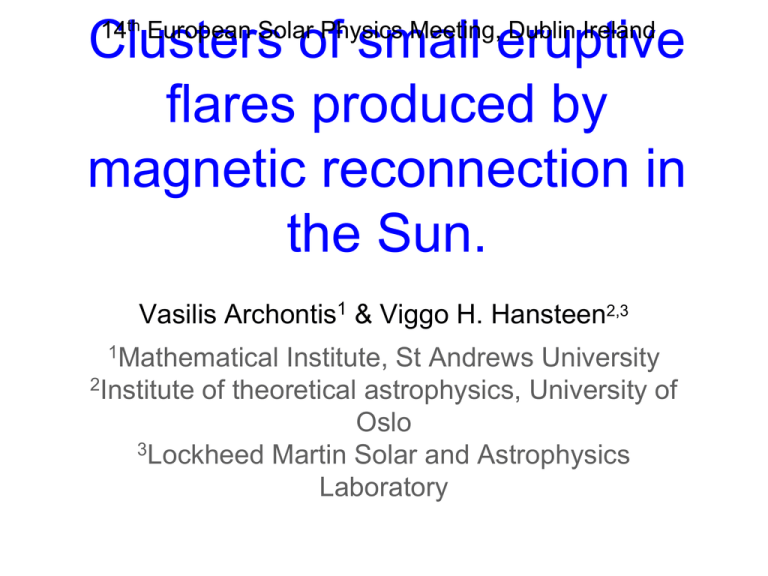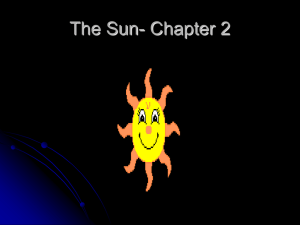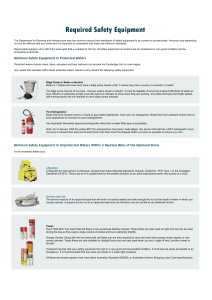Clusters of small eruptive flares produced by magnetic reconnection
advertisement

Clusters of small eruptive flares produced by magnetic reconnection in the Sun. 14th European Solar Physics Meeting, Dublin Ireland Vasilis Archontis1 & Viggo H. Hansteen2,3 1Mathematical Institute, St Andrews University 2Institute of theoretical astrophysics, University of Oslo 3Lockheed Martin Solar and Astrophysics Laboratory Overview • Numerical experiments: initial conditions. • Flux emergence at/above the photosphere. • Plasmoid-induced-reconnection. • Fragmentation of current layers / intermittent heating. • Onset of small flares (nano/micro-flares). • Heating of the active corona. Bifrost simulations Hansteen 2004, Hansteen, Carlsson, Gudiksen 2007, Martínez Sykora, Hansteen, Carlsson 2008, Gudiksen et al 2011 Numerical set-up Stratification & magnetic field Z Y X Emerging field (flux sheet). Ambient magnetic field (oblique, space filling). Archontis & Hansteen, 2014 • CZ (z=-2.5 Mm). • PHOT./CHR. (z=0-2.5 Mm). T~ 5 103 – O(105) K. • TR (z~2.5-4 Mm). • COR. (z~4 Mm). T ~ O(106) K. • 24x24x17 Mm, 504x504x496 grid. • Convection is driven by optically thick radiative transfer from the photosphere. • Radiative losses in the chrom. include scattering, optically thin in the corona. • Field-aligned thermal conduction is included. • Hyper-diffusion is included. • Initial ambient field of B~0.1 G with inclination of 45o with respect to z axis. • Flux sheet (Bx=3300 G at bottom boundary) within [x,y]=[0-24,3-16 Mm] for 105 min. 1st phase: emergence to the photosphere • Vertical slices at y~10 Mm. • Horizontal slices at z~700 km above phot. • Intensity: continuum, 630 nm & CaII 854.2 nm. • B-flux elements pile up (surface) for ~15 min. • Bphot = 500-600 G (max=1-1.5 kG). • B-field emerges above the surface after ~2hrs. • Chromospheric temperature structure set by acoustic shocks, oscillations etc. until magnetic field emerges into outer atmosphere. • Photospheric and chromospheric intensity little changed by flux emergence during 1st phase. • Larger granules appear at the beginning of 2nd phase. 2nd phase: emergence above the photosphere • The emerging field enters the corona. • Emerging loops: dense and cool (adiabatic expansion). • Photosphere: granule size change, bright points. • Chrom/corona: local temperature increase. • (Low) chromosphere intensity and contrast increase. • Acoustic shock structure severely modified by magnetic field as waves are expelled from cool emerging ‘bubbles’. • Magnetic loops interact (e.g. reconnect). See Ortiz et al. 2014, ApJ 781, 126. for this phase. Multi-scale emergence of magnetic flux Evolution across the current sheet • Long, thin current layer. • Tearing instability – plasmoids. • Ejection of plasmoids – reconnection – X-ray temperatures. • Jets (V~200-400 km/s, T~2.5 mK). • Small flare loops (T~ 2 mK). • Heat conduction – Chrom. heating. • Lifetime of flaring: <=100 s. • Energy release: 1025 – 1026 erg. CSHKP (2D view) Standard reconnection flare model(s) Carmichael 1964, Sturrock 1966, Hirayama 1974, Kopp-Pneuman 1976 Shibata, et.al. ApJ 451, L83, 1995. Plasmoid ejection associated with LDE flare (Yohkoh/SXT) Evolution along the current sheet • Not one but several plasmoids. • Patchy reconnection – spatially intermittent heating. • Cluster of small flares. • Fragmentation of current. • Many sites of acceleration. • One flare stimulates(?) the other. “Sympathetic” flaring? • Larger energy release: the composite effect of the adjacent small flares. • Energy release: 1027 – 1028 erg. 3D view: plasmoids, heating, jets, flares. • • • • Isosurfaces: (red) T≥5.5 105 K, (blue) ρ ≈ 10-12 g cm-3 . zslice=3.14 Mm, t=8800 s. Intense heating where strong currents. “Sympathetic” eruptions / flaring. • Eruptions evolve into helical jets (EUV/X-ray). • Cusp-shaped flare loops. Temperature, vertical velocity (VZ) and energy. • Plasma heating (1-6 mK) by small flares. • Reconnection-driven acceleration. • Heating-Energy: good correlation. • Short-lived bursts of energy. • Superposition of small flares (10251026 erg). • “Individual” energy emissions ~(1027) erg. • Lifetime of small flares: 30 s – 3 min. • Flares at various heights. • ~ 20 flares in 38 min. • For coronal flares: average energy flux ~ 2.1x106 - 107 erg s-1 cm-2 . • • • • • • • Discussion/Summary Ejection of plasmoids leads to ‘patchy’ reconnection and, thus, spatially intermittent heating. Plasmoids share field lines, thus the eruption of one plasmoid initiates the "sympathetic" eruption of others. Eruption of plasmoids evolves into helical jets. Velocities comparable to local Alfvén speed. Average lifetime of individual small flares is of order 30 s - 3 minutes. Plasma heated to 1-6 MK. Some larger flares have energies of O(1027) erg, but many events are superpositions of several small flares; 1025-1026 erg. For the flares in the corona: average energy flux O(106) ergs s-1 cm-2. Non-negligible contribution of heating in the active corona from small flares.




